Every once in awhile, you get a team in the UEFA Champions League completely outperform expectations. Ajax were that team last season, arguably Atalanta this year, but in the season of 2016/17, it was a French team, AS Monaco. With Leonardo Jardim at the helm and their attack spearheaded by Kylian Mbappé, they got all the way to the semi-finals.
2016/17 also happened to be Pep Guardiola’s first season at Manchester City. Arriving to great expectations after dominant spells at Barcelona and Bayern Munich, he eventually had his only trophy-less season in management. Part of that was down to the qualities of this Monaco side. A chaotic two-legged Round of 16 tie dumped City out on away goals after drawing 6-6 on aggregate. This piece will look specifically at the 5-3 home leg victory for the Citizens.
In this tactical analysis I will look at the tactics of Manchester City versus Monaco. This piece will use analysis to see why City got the better of the French side in the home leg.
Line-ups
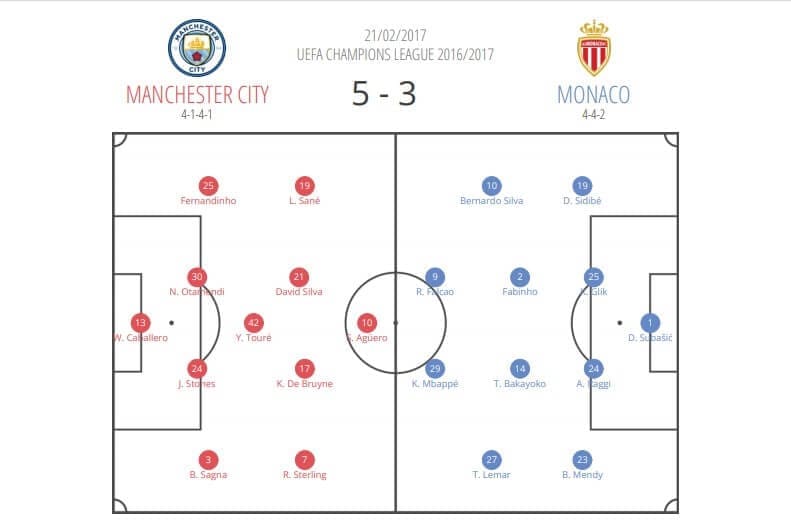
The development of Guardiola’s City side was still in its infancy at this stage, and this was demonstrated by the personnel picked. Yaya Toure was chosen as the pivot while the regular Fernandinho played in an unusual role of left-back. Bacary Sagna was also still prevalent, playing right-back in this game. The forwards were the same we’ve come to expect from this Guardiola team.
Jardim included all his renowned superstars in this starting 11. Two future Man City players participated: Bernardo Silva at right-wing as well as Benjamin Mendy as an adventurous left-back. Mbappé had veteran striker Radamel Falcao alongside him providing experience to his rawness. Also included was Fabinho, in his role as midfield protector.
Man City’s build-up (issues)
Playing out of the back is a key principle of Guardiola’s tactical philosophy. Clean ball progression is of paramount importance. Because many teams opt for a low block against Man City – especially at the Etihad – then it can be a useful tactic in creating space in more offensive positions for the likes of David Silva and Kevin De Bruyne to thrive. You can attract opponents out of their settled, defensive shape to be more aggressive.
After the arrival of more attacking full-backs in recent times, such as the purchase of Mendy in summer of 2017, the wingers chosen were played on the side of their strongest foot. This permits them to attack the by-line to a greater, more effective extent – particularly helpful for Leroy Sane. Diagonal runs in-behind an unimpressive, slow Monaco defence could be more successful with this approach as well. The primary purpose of this tactic though is to stretch the Monaco press/defence. With Jardim’s side lining up in a 4-4-2, the lack of lines whereby players are situated on makes it vulnerable to being manipulated.
By situating his wingers on the touchline, it forces Fabinho and Tiémoué Bakayoko to cover more ground. They can either compress one wing to force Man City to recirculate, but this would leave the opposite wing freer for a quick switch of play, something City are usually good at. Another option is ensuring the central third is compact, thus sacrificing the wide areas.
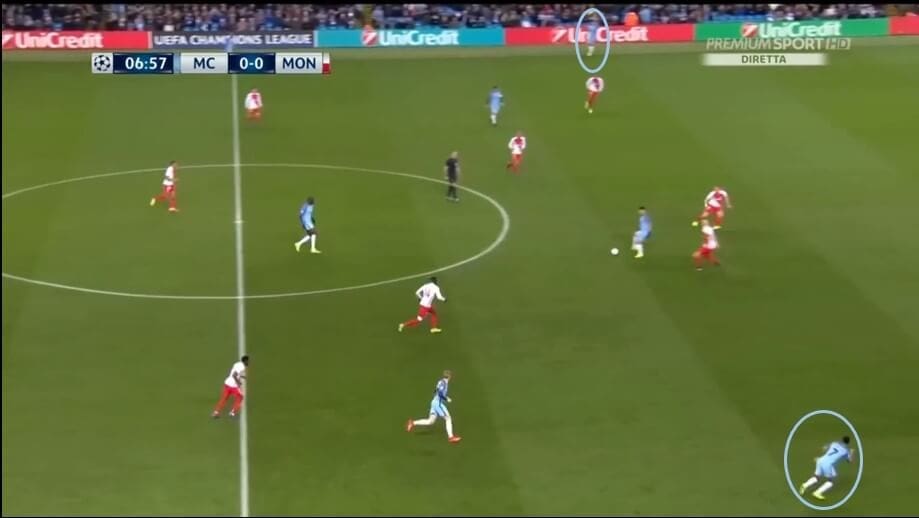
In the example above we see the width of the positioning of Sane on the left and Raheem Sterling on the right. This portrays how them even being slightly occupied by the Monaco full-backs results in free space opening up centrally.
However, much like Guardiola’s first season at Manchester, problems arose for City. Just as beginning attacks from the goalkeeper is a non-negotiable so is having numerical superiority in this vital phase-of-play. A major factor for Guardiola’s first season being unsuccessful was the lack of a goalkeeper being consistent, but also supremely comfortable with the ball at their feet. Including the keeper as an extra outfield player is an extra obstacle for the opposition press. Willy Caballero’s performance with the ball at his feet wasn’t particularly convincing.
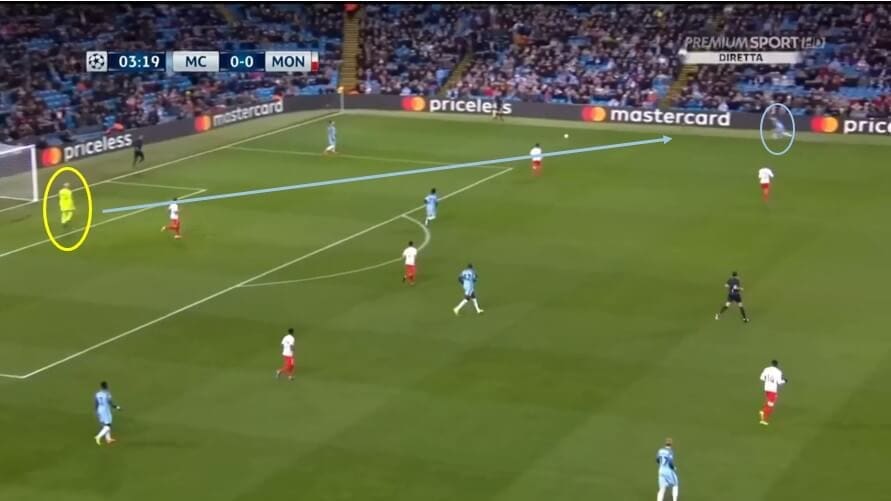
The Argentine simply doesn’t have the kicking ability of Ederson to launch balls for Sergio Aguero to attack. In the present day, this has offered increased variability to the City build-up, with opponents now needing to be wary of leaving too much room behind their last line. Above we see Caballero attempts to drill a ball out to Fernandinho at left-back but instead puts it out for a throw-in.
Whilst Touré had a sparkling career in Manchester, at this point he was in the twilight of that spell. Fernandinho subsequently emerged as an undroppable cog in Guardiola’s system due to his intuitive ability to be in the right position to offer support under pressure or generally be in space and form angles. In this game, we saw how positional awareness was lacking from a pivot. In this first scenario below Touré is too static, not enough attempt is made to find a pocket of space and escape Falcao.
Moreover, he is on the blindside of Falcao, facilitating simpler space-creating movements. In the image below we can also see John Stones free, whilst not available to Caballero, Touré can offer the keeper an option to then subsequently play a third man pass to relieve pressure.
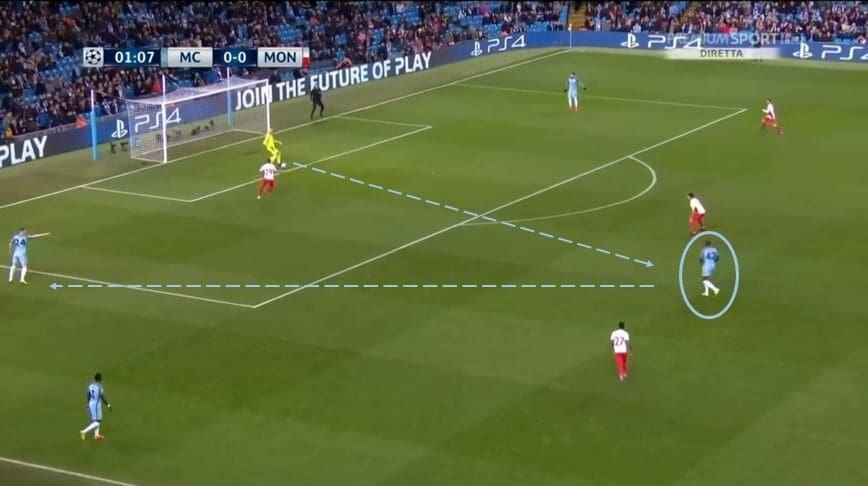
A similar situation arises below. Stones and Nicolas Otamendi are rotating the ball between them searching for a viable passing lane. But, Touré is once more passive, only ambling laterally. In the pivot role, the player picked must remain engaged, constantly trying to disrupt the opposition shape. Instead, the Ivorian remains in Falcao’s cover shadow forcing the ball backwards.
Due to Touré’s immobility, the centre-backs were sometimes forced to be more direct, which wasn’t extremely beneficial, because of the lack of height in City’s attack.
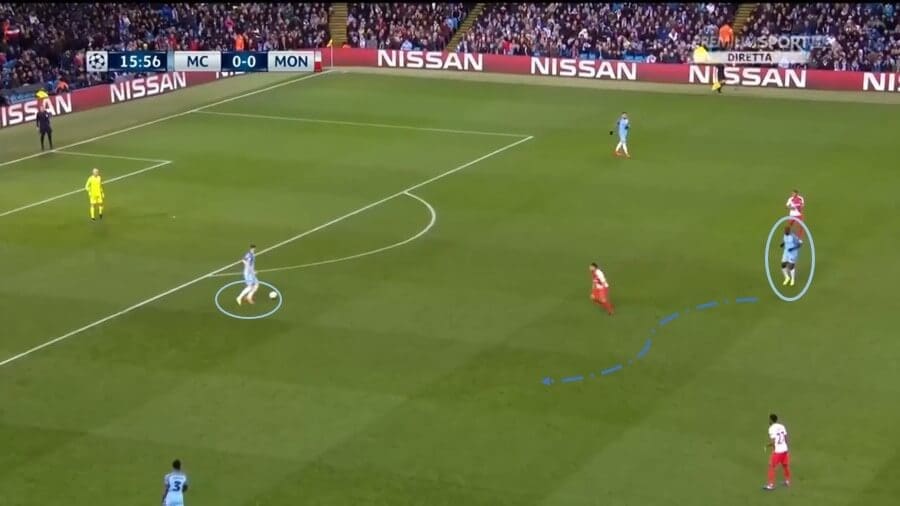
Interestingly, the times where Touré was at his most effective was when he slotted in alongside Stones and Otamendi and was facing forward upon receiving the ball. Picking up the ball in a deeper position allowed him to have the ball for longer and under less pressure, giving him greater license to utilise his technical ability.
Furthermore, this gave the City build-up numerical superiority over the front two of Falcao and Mbappé. Touré’s deeper positioning also facilitated the inverting of Fernandinho to the pivot role the Brazilian is used to. We can see an example of this happening below.
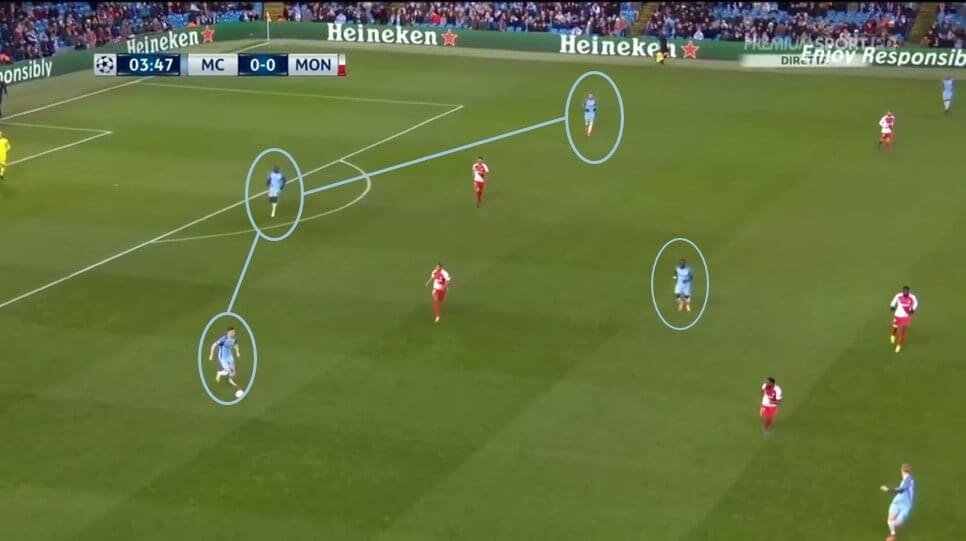
To aid build-up in more complex, intense situations, the two advanced centre-midfielders, Silva and De Bruyne could come deeper. These two were commonly located in the respective half-spaces where they could turn and drive after receiving. If the full-backs did invert, they pulled wider to maintain balance and optimum width.
Being located in the half-spaces, and on staggered vertical lines, generated more dilemmas for Monaco, meaning the task to remain defensively compact increased in difficultly.
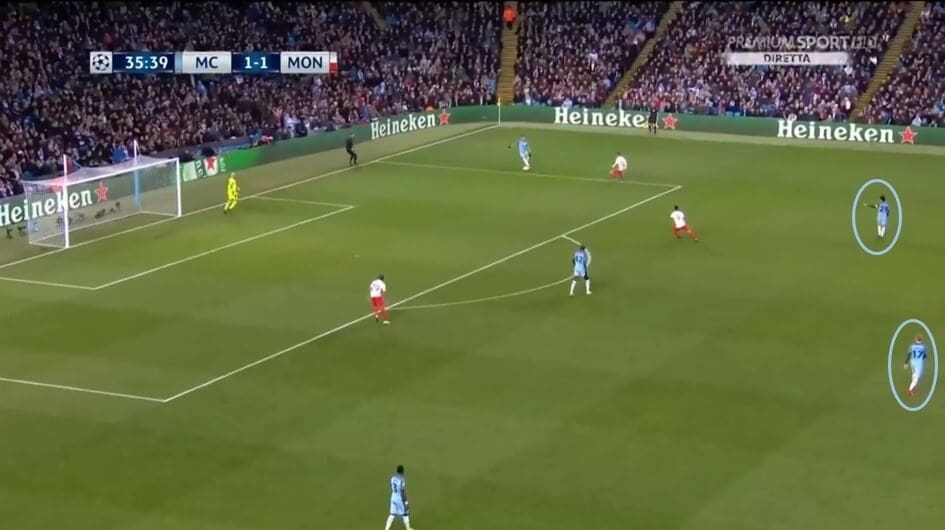
Monaco’s defensive strategy
Monaco were generally rather aggressive in trying to subdue the home side’s attacking play. This primarily meant employing an intense press. Out-of-possession Falcao and Mbappé became a two. This meant they had numerical equality with the two centre-backs. As I have explained previously, they also blocked off simple passing lanes to Touré in the pivot, thus directing play out wide or allowing simple play between Stones and Otamendi. However, instances where this occurred was when Monaco had settled into a mid-block and City had stable possession.
From goal kicks the away side were less passive. Their pressing structure in these situations tended to be asymmetrical, with an increased focus on Monaco’s right-side. It is visible in the image below. Right-winger Bernardo Silva has advanced to be level with the front two, ready to press Otamendi whilst also stopping D. Silva receiving, and blocking the direct passing lane to left-back Fernandinho. Left-winger Thomas Lemar has held his position to be beside Bakayoko who is shepherding De Bruyne. This may be because De Bruyne is more advanced than D. Silva and the ability he possesses.
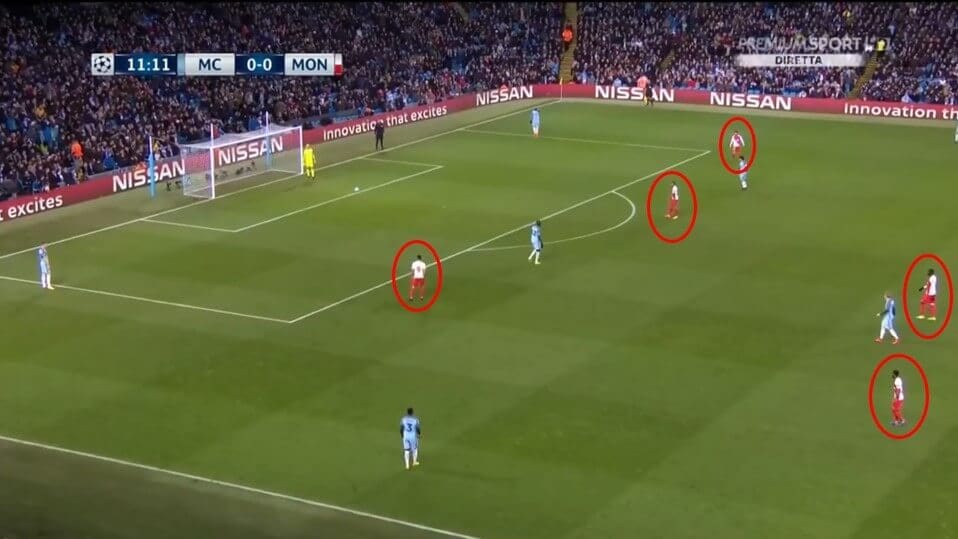
Another comparable example is shown below where you can also see the midfield line. Fabinho and Bakayoko do need to step up at times to follow De Bruyne and Silva and prevent them from receiving easily which would make the forward three’s efforts worthless and would be an unproductive use of energy. This then makes it vital that the organisation is sturdy for vertical solidity to be abided by.
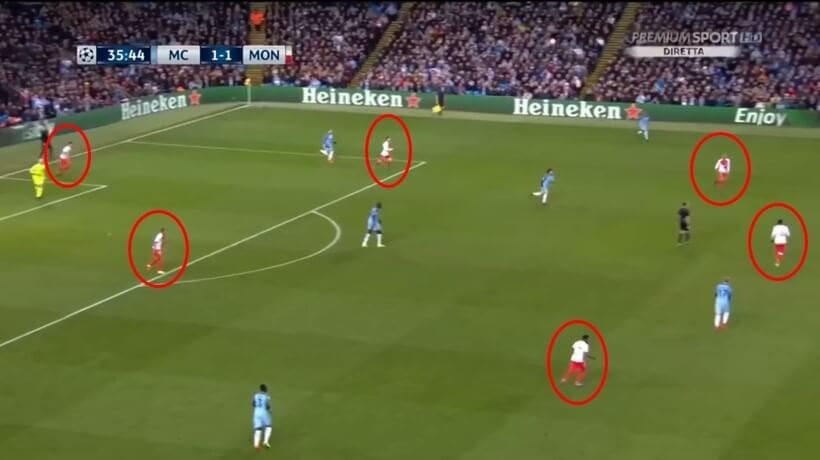
Other than goal kicks one pressing trigger is when the ball is deep and wide. In the image below Stones is in possession. First, Mbappé is pressing the Englishman intensely forcing the ball back to Caballero.
By curving his run, the youngster hassles Caballero, resulting in a loss of possession for City. A high-press not only requires an excellent structure – even more prevalent against a Guardiola side – but necessary effort to apply the tactic to maximum effect.
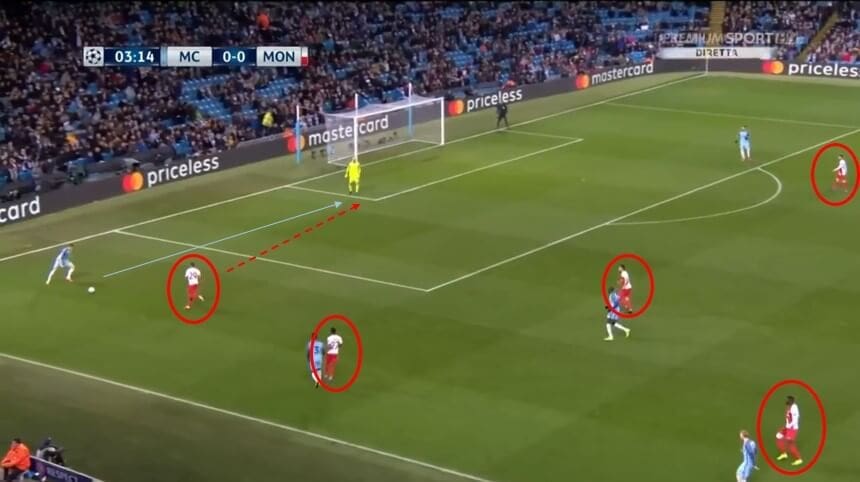
Jardim’s side did naturally face defensive problems. These were mainly borne out of a lack of central compactness – the complexity and fluidity of play from Man City will inevitably see gaps emerge, it is just whether they can be sufficiently exploited. The scenario below illustrates it well.
Bakayoko has been drawn out too far, to compound this Fabinho hasn’t shifted across to cover that newfound central space. The home side then initiates an up-back-through manoeuvre to release Silva. The Spaniard then plays in Sane wide-left but he wastes the opportunity.
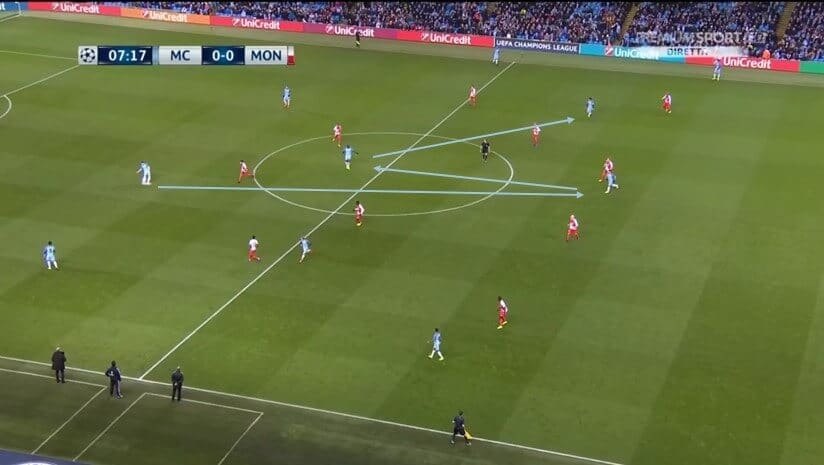
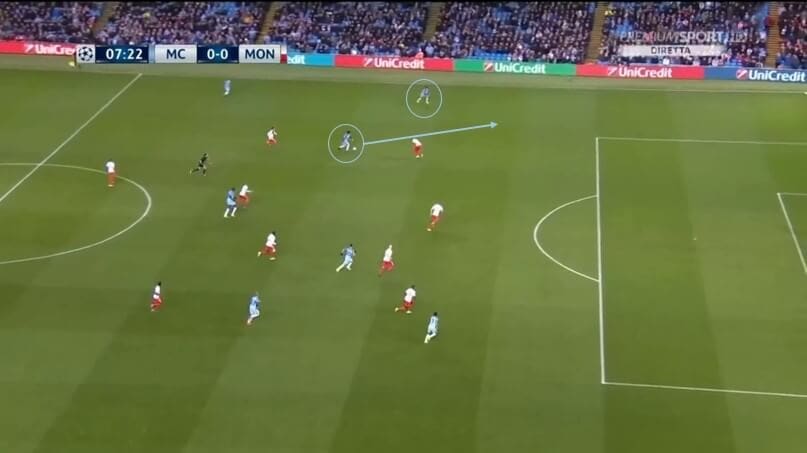
Two of the five goals scored by City came from corners. Monaco’s defensive set-up for corners is man-to-man. Therefore, opponents can become free if they slip their markers attention, which what happened for City’s fourth, seen below. Toure jumped highest to get the slightest touch to divert the ball towards Stones who are got around Kamil Glik’s blindside.
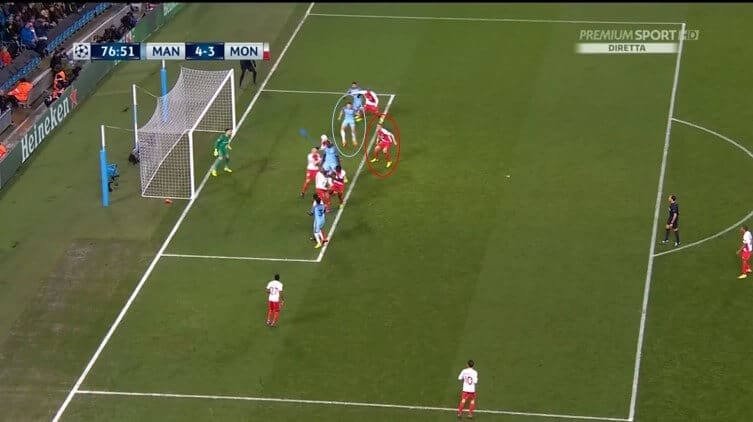
Importance of inverted full-backs
Since his spell at Bayern Munich Guardiola has implemented this tactic. The main reason is to maximise the space for his superior wide players to operate in.
But, in this Monaco game, Guardiola faced an issue with defensive transitions in the face of the ball-carrying ability of Monaco’s attackers. Lemar, Silva and Mbappé all have exceptional dribbling ability which led Jardim to elect for a counter-attacking style. On numerous occasions in the first half, the French side exploited City’s attacking nature. Either by direct dribbling or depth runs, stretching the defence created a disconnect too large for Guardiola’s liking.
To counter this Fernandinho was allowed freedom to venture into his usual area of the field. Such an instruction served two purposes: another defensive-minded player centrally to curb the attacking transitions from Monaco that were proving problematic; further assist build-up with two players technically capable now on the second line to play incisive passes. The importance of this alteration is displayed by 58% of Monaco attacks coming centrally, generating 1.46 xG.
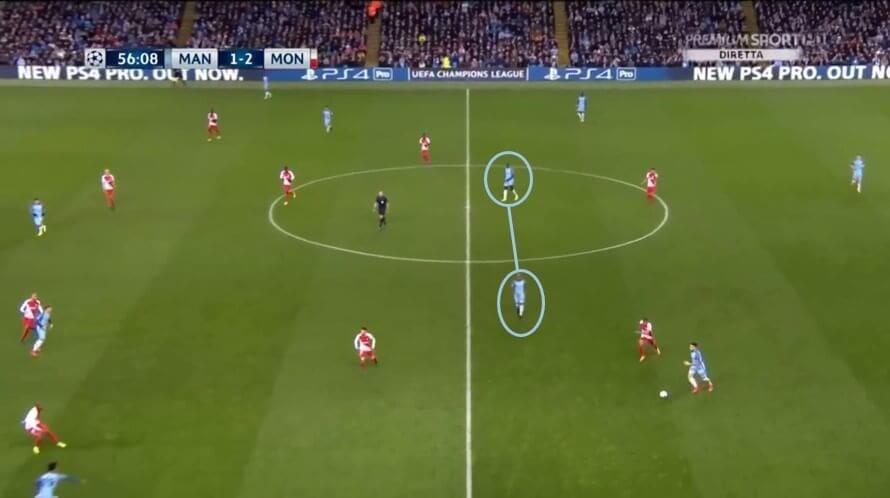
In the image above Fernandinho unorthodox positioning for a left-back is evident. The 34-year-old is stationed on the same line as Touré. In the following moments, shown below, we see the benefits of this strategy, something missed in the first half.
Sane is engaged by B. Silva after receiving off Otamendi but now has an additional midfield option in Fernandinho, who can exploit the now unoccupied space following Silva’s committal.
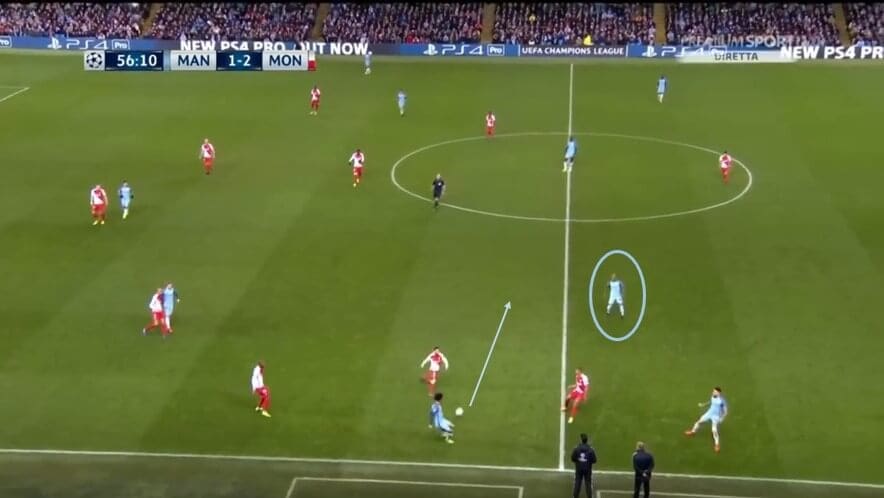
Below is an example of the increased protection Fernandinho provided in the second 45. B. Silva is in close proximity especially, plus the Portuguese international is very left-footed which lends itself to coming inside.
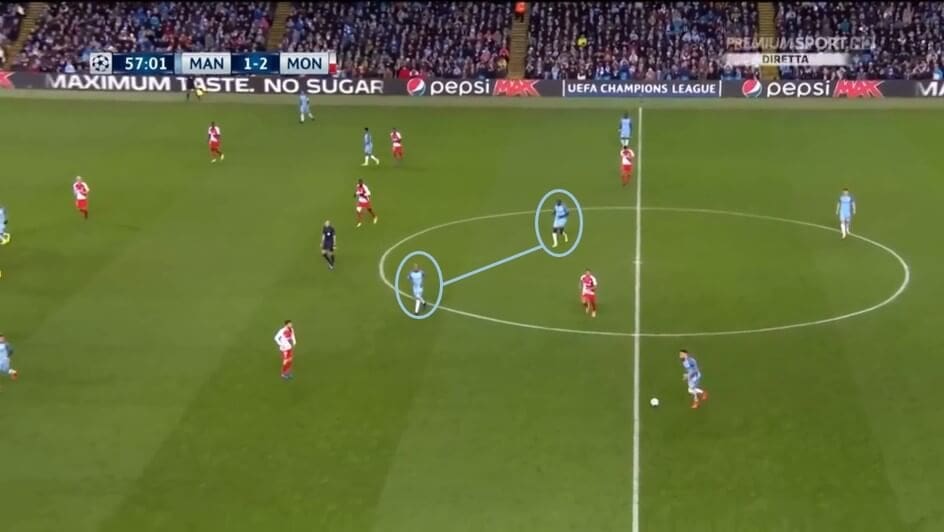
The physical duo of Fernandinho and Touré, in addition to the mobility of Stones and Otamendi especially, gave the home side greater defensive security when it was much needed.
Conclusion
Whilst City had flashes of their brilliance that was to come in the ensuing seasons the statistics implied what was to come in the second leg. Going by xG the home side lost. Monaco registered 2.67 xG, whereas Man City posted 2.47 xG. The potency of the Monaco attack would come to fruition in the second leg.
Whilst some of Guardiola’s starting 11 would go on to play key roles in their subsequent success many involved here would have no future in Manchester. Touré’s influence would gradually decline, Sagna left at the end of 2016/17, as did Pablo Zabaleta who came on a substitute here. Furthermore, it was clear how the more advanced principles of the Catalan’s tactical philosophy had not been fully assimilated, such as their build-up scheme.






Comments